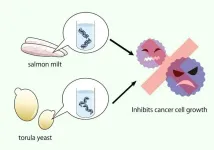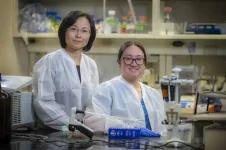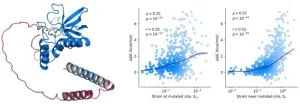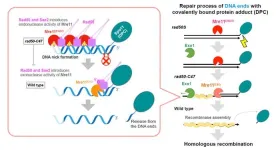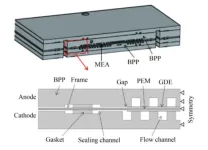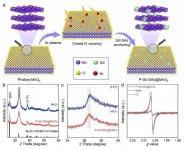(Press-News.org) Children can work together to reach a target that benefits a whole group even if it is at a personal cost to themselves, a new study has shown.
Researchers invited groups of six to 10-year-olds to take part in a game where they were each given containers of water and could decide how much of it to offer into a common pool.
If the group contributed a certain amount of water it resulted in benefits for the whole group, but children also obtained benefits for any water they kept.
At the same time, the participants were either given feedback about their own outcomes in the game or about everyone’s outcomes.
The results showed the majority of groups achieved their objectives and cooperated until the last round of the game, even when children observed the outcomes of others within their groups.
However, those who did see everyone’s outcomes were somewhat less likely to keep reaching the threshold as the game progressed, and differences in individual outcomes became more noticeable.
Researchers say the findings provide valuable insights into how groups of people can work together to overcome communal challenges and demonstrate the effectiveness of setting clear and unambiguous targets.
The study is published in the journal Psychological Science and involved researchers from the University of Plymouth (UK), Freie Universität Berlin and the Max Planck Institute for Human Development (Germany), and the IESE Business School (Spain).
Dr Patricia Kanngiesser, Associate Professor in Psychology at the University of Plymouth and the study’s lead author, said: “A lot of the challenges facing society today involve choices between one’s self-interest and contributing to the greater good. That is certainly the case if we think about things like climate action, where targets can only be achieved if people and nations work together. Our study shows that working towards a clear target can yield results that ultimately benefit everyone. And even children as young as six can do it.”
The study is the latest by Dr Kanngiesser and Plymouth colleague Dr Jan Woike to use games to study human behaviour and investigate ways to promote cooperation.
It also allowed them to explore findings from previous research, which showed that having the opportunity to compare own and others’ outcomes can lead to competition and decrease willingness to contribute to the common good.
For the purposes of this study, children had the opportunity to talk during the game and spoke, for example, about reaching the common goal.
When children had the chance to see everyone’s outcomes, they compared their own and others’ performances more frequently.
They also talked more in general and mentioned the act of giving water more, showing that children reacted to different situations in a flexible manner and increased their efforts to coordinate when circumstances demanded it.
Dr Kanngiesser added: “This game focused on children at an age where they develop a sense of competition. We might have expected that to become a factor when the children realised how others in their group were behaving, but that was largely not the case. It demonstrates that with meaningful targets and the right feedback, we can help individuals to look beyond their own self-interest towards action that has the potential to benefit society more broadly.”
How the game worked
The study recruited 240 children from Germany and India. In the game, groups of three children were given containers of water and were invited to contribute a proportion of their water to a common pool. They individually kept any water that they did not contribute.
Reaching a certain threshold in that pool would enable them to help a thirsty animal and everyone in the group received the same amount of additional water, irrespective of the degree to which they had contributed. The more water each child collected, the more rewards the child received at the end of the game. This created an incentive for children to try to keep as much of their own water as possible.
The game consisted of eight rounds. Children in half of the groups were only shown how much water they had collected themselves after each round. In the other groups, children saw how much they and everyone else had collected.
END
Children contribute to group projects when there are clear and common goals
2024-08-29
ELSE PRESS RELEASES FROM THIS DATE:
Dine on DNA: Compounds from nucleic acids in food show anticancer effects
2024-08-29
When people eat, they ingest the nucleic acids that reside in all living things. The compounds in these acids could inhibit the growth of cancer cells, according to findings published in PLOS ONE by Osaka Metropolitan University Associate Professor Akiko Kojima-Yuasa of the Graduate School of Human Life and Ecology and colleagues.
Consuming nucleic acids found in food has been shown to boost the immune system and prevent some diseases. The nucleotides and nucleosides that result from digesting the acids are largely responsible for these beneficial effects.
Professor ...
MCG scientists working to understand why men with prostate cancer are at higher risk of Alzheimer’s
2024-08-29
AUGUSTA, Ga. (Aug. 29, 2024) – Researchers at the Medical College of Georgia at Augusta University are searching for a better way to understand why many men with prostate cancer end up with Alzheimer’s disease, and whether it’s the standard hormone therapy treatment or an overactive immune response that actually contributes to the problem.
The hormone therapy, androgen deprivation therapy, known as ADT, treats the cancer by reducing testosterone, which the cancer needs to grow. But androgen is a key regulator of amyloid metabolism and when it’s removed from the equation, more amyloid is left to form the plaques that are a hallmark of Alzheimer’s.
“We ...
Ancient sea cow attacked by a crocodile and sharks sheds new light on prehistoric food chains
2024-08-29
A new study describing how a prehistoric sea cow was preyed upon by not one, but two different carnivores – a crocodilian and a shark – is revealing clues into both the predation patterns of ancient creatures and the wider food chain millions of years ago.
Published in the peer-reviewed Journal of Vertebrate Paleontology, the findings mark one of the few examples of a creature being preyed upon by different animals during the Early to Middle Miocene epoch (23 million to 11.6 million years ago).
Predation marks in the skull indicate that the dugongine sea cow, ...
Georgia Tech neuroscientists explore the intersection of music and memory
2024-08-29
By Jerry Grillo
The soundtrack of this story begins with a vaguely recognizable and pleasant groove. But if I stop writing and just listen for a second, the music reveals itself completely. In Freddie Hubbard’s comfortable, lilting trumpet solo over Herbie Hancock’s melodic, repetitive piano vamping, I recognize “Cantaloupe Island.” Then, with my fingers again poised at the keyboard, Freddie and Herbie fade into the background, followed by other instrumental music: captivating — but not distracting — sonic nutrition, feeding my concentration and productivity.
Somewhere, I think, Yiren Ren is studying, focused on her ...
Waging war on ‘superbugs’ in aged care
2024-08-29
There’s an urgent need for more careful antibiotic management to protect older people living in residential aged care from the dangerous spread of antibiotic resistant bacteria or ‘superbugs’, researchers from Flinders University and SAHMRI warn.
A new study published in the well-respected Journal of Infection, explores the link between the widespread use of antibiotics in residential aged care and the resulting antibiotic resistant bacteria in the gut that can be passed on to other residents.
“Commonly ...
Increasing risk of synthetic opioid drug overdoses in Australia
2024-08-29
A recent study has uncovered alarming insights into the dangers posed by fentanyl-contaminated drug supplies in Australia, including a heightened risk of lethal overdose.
The study, titled ‘The gear could be cut with fentanyl which is starting to happen more in Australia’: Exploring Overdose Survivors’ Perspectives on Toxic Supply and Safe Consumption, aimed to explore the role of synthetic opioids in overdoses among Queenslanders.
Led by Griffith University’s Dr Timothy Piatkowski, Emma Kill and Steph Reeve in partnership with the Queensland ...
Protein mutant stability can be inferred from AI-predicted structures
2024-08-29
Researchers at the Center for Algorithmic and Robotized Synthesis within the Institute for Basic Science have taken a significant step forward in understanding the stability of proteins by leveraging the power of AI. The research team used AlphaFold2 to explore how mutations affect protein stability—a crucial factor in ensuring proteins function correctly and do not cause diseases like Alzheimer's.
DeepMind’s AlphaFold algorithm, which can accurately predict a protein’s structure from ...
Shedding light on the mechanism of yeast DNA repair
2024-08-29
DNA damage is a cellular phenomenon that introduces structural abnormalities in double-stranded DNA. External factors, such as radiation or chemical agents, as well as internal factors, such as blocked DNA replication, can generate double-strand breaks (DSBs) in DNA. To counteract DNA damage, cells engage in DNA repair to preserve genetic integrity and ensure cell survival as failure to repair DSBs has serious health complications like increased risk of cancer.
DSBs are repaired by two mechanisms called non-homologous end joining (NHEJ) and homologous recombination (HR). NHEJ is the predominant DNA repair mechanism in human somatic cells and is ...
Improvement of durability of membrane electrode assembly by frame sealing structure in temperature shock
2024-08-29
Fuel cells offer a promising solution for clean energy with advantages over traditional electric power systems, including extended driving range and higher energy density. Despite these benefits, the high costs and durability concerns associated with fuel cell stacks have limited their commercialization. The durability of membrane electrode assemblies (MEAs), a key component of proton exchange membrane fuel cells (PEMFCs), is particularly affected by the frame sealing structure, which is often overlooked in research.
The study, conducted by Tiankuo Chu ...
Rare earth single atoms enhance manganese oxide's electrochemical oxygen evolution
2024-08-29
An international group of researchers has developed a novel approach that enhances the efficiency of the oxygen evolution reaction (OER), a key process in renewable energy technologies. By introducing rare earth single atoms into manganese oxide (MnO2), the group successfully modulated oxygen electronic states, leading to unprecedented improvements in OER performance.
Their findings were published in the journal Nano Energy on June 10, 2024.
Transition-metal-based oxides have been widely explored for their potential as active OER catalysts. However, the capacity of these catalysts is hindered by the adsorbate evolution mechanism, which ...
